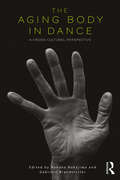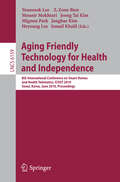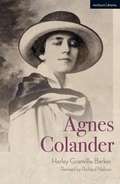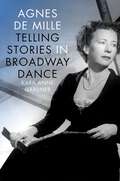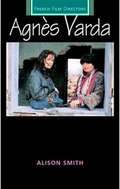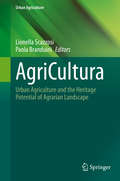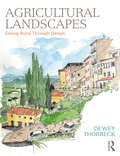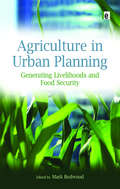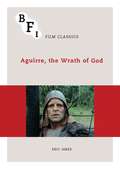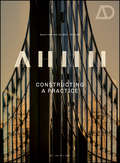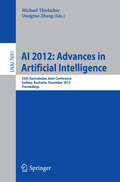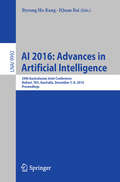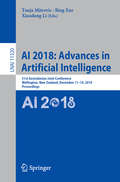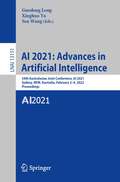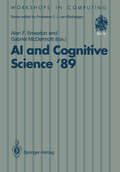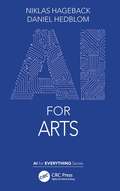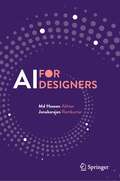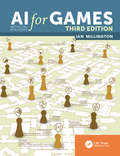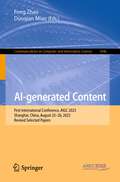- Table View
- List View
The Aging Body in Dance: A cross-cultural perspective
by Gabriele Brandstetter Nanako NakajimaWhat does it mean to be able to move? The Aging Body in Dance brings together leading scholars and artists from a range of backgrounds to investigate cultural ideas of movement and beauty, expressiveness and agility. Contributors focus on Euro-American and Japanese attitudes towards aging and performance, including studies of choreographers, dancers and directors from Yvonne Rainer, Martha Graham, Anna Halprin and Roemeo Castellucci to Kazuo Ohno and Kikuo Tomoeda. They draw a fascinating comparison between youth-oriented Western cultures and dance cultures like Japan’s, where aging performers are celebrated as part of the country’s living heritage. The first cross-cultural study of its kind, The Aging Body in Dance offers a vital resource for scholars and practitioners interested in global dance cultures and their differing responses to the world's aging population.
Aging Friendly Technology for Health and Independence: 8th International Conference on Smart Homes and Health Telematics, ICOST 2010, Seoul, Korea, June 22-24, 2010, Proceedings (Lecture Notes in Computer Science #6159)
by Yeunsook Lee Z. Zenn Bien Mounir Mokhtari Jeong Tai Kim Mignon Park Jongbae Kim Heyoung Lee Ismail KhalilWe are living in a world full of innovations for the elderly and people with special needs to use smart assistive technologies and smart homes to more easily perform activities of daily living, to continue in social participation, to engage in entertainment and leisure activities, and to enjoy living independently. These innovations are inspired by new technologies leveraging all aspects of ambient and pervasive intel- gence with related theories, technologies, methods, applications, and services on ub- uitous, pervasive, AmI, universal, mobile, embedded, wearable, augmented, invisible, hidden, context-aware, calm, amorphous, sentient, proactive, post–PC, everyday, autonomic computing from the engineering, business and organizational perspectives. In the field of smart homes and health telematics, significant research is underway to enable aging and disabled people to use smart assistive technologies and smart homes to foster independent living and to offer them an enhanced quality of life. A smart home is a vision of the future where computers and computing devices will be available naturally and unobtrusively anywhere, anytime, and by different means in our daily living, working, learning, business, and infotainment environments. Such a vision opens tremendous opportunities for numerous novel services/applications that are more immersive, more intelligent, and more interactive in both real and cyber spaces.
Agnes Colander (Modern Plays)
by Harley Granville BarkerWe should all have been taught more of life and less good mannersIt is three years since Agnes, an artist, left her unfaithful husband Henry. Now he writes to her in her Kensington studio begging to reunite, but Agnes married young; her innocence has gone and her ambition and independence is growing. As she travels from London to France, Agnes finds herself torn between Otho, a worldly Danish artist and Alec, an infatuated younger suitor, between a longing to paint and be an independent woman and a yearning to be loved.This witty and compelling exploration of love, sexual attraction and independence was written in 1900 and unearthed among Granville Barker's papers in the British Library a century later. Revised by playwright and librettist Richard Nelson this edition was published to coincide with the world premiere at the Theatre Royal Bath in Spring 2018.
Agnes Colander (Modern Plays)
by Harley Granville BarkerWe should all have been taught more of life and less good mannersIt is three years since Agnes, an artist, left her unfaithful husband Henry. Now he writes to her in her Kensington studio begging to reunite, but Agnes married young; her innocence has gone and her ambition and independence is growing. As she travels from London to France, Agnes finds herself torn between Otho, a worldly Danish artist and Alec, an infatuated younger suitor, between a longing to paint and be an independent woman and a yearning to be loved.This witty and compelling exploration of love, sexual attraction and independence was written in 1900 and unearthed among Granville Barker's papers in the British Library a century later. Revised by playwright and librettist Richard Nelson this edition was published to coincide with the world premiere at the Theatre Royal Bath in Spring 2018.
Agnes de Mille: Telling Stories in Broadway Dance (Broadway Legacies)
by Kara Anne GardnerThis book explores the Broadway legacy of choreographer Agnes de Mille, from the 1940s through the 1960s. Six musicals are discussed in depth - Oklahoma!, One Touch of Venus, Bloomer Girl, Carousel, Brigadoon, and Allegro. Oklahoma!, Carousel, and Brigadoon were de Mille's most influential and lucrative Broadway works. The other three shows exemplify aspects of her legacy that have not been fully examined, including the impact of her ideas on some of the composers with whom she worked; her ability to incorporate a previously conceived work into the context of a Broadway show; and her trailblazing foray into the role of choreographer/director. Each chapter emphasizes de Mille's unique contributions to the original productions. Several themes emerge in looking closely at de Mille's Broadway repertoire. Character development remained at the heart of her theatrical work work. She often took minor characters, represented with minimal or no dialogue, and fleshed out their stories. These stories added a layer of meaning that resulted in more complex productions. Sometimes, de Mille's stories were different from the stories her collaborators wanted to tell, which caused many conflicts. Because her unique ideas often got woven into the fabric of her musicals, de Mille saw her choreography as an authorship. She felt she should be given the same rights as the librettist and the composer. De Mille's work as an activist is an aspect of her legacy that has largely been overlooked. She contributed to revisions in dance copyright law and was a founding member of the Stage Directors and Choreographers Society, a theatrical union that protects the rights of directors and choreographers. Her contention that choreographers are authors who have their own stories to tell offers a new way of understanding the Broadway musical.
Agnes de Mille: Telling Stories in Broadway Dance (Broadway Legacies)
by Kara Anne GardnerThis book explores the Broadway legacy of choreographer Agnes de Mille, from the 1940s through the 1960s. Six musicals are discussed in depth - Oklahoma!, One Touch of Venus, Bloomer Girl, Carousel, Brigadoon, and Allegro. Oklahoma!, Carousel, and Brigadoon were de Mille's most influential and lucrative Broadway works. The other three shows exemplify aspects of her legacy that have not been fully examined, including the impact of her ideas on some of the composers with whom she worked; her ability to incorporate a previously conceived work into the context of a Broadway show; and her trailblazing foray into the role of choreographer/director. Each chapter emphasizes de Mille's unique contributions to the original productions. Several themes emerge in looking closely at de Mille's Broadway repertoire. Character development remained at the heart of her theatrical work work. She often took minor characters, represented with minimal or no dialogue, and fleshed out their stories. These stories added a layer of meaning that resulted in more complex productions. Sometimes, de Mille's stories were different from the stories her collaborators wanted to tell, which caused many conflicts. Because her unique ideas often got woven into the fabric of her musicals, de Mille saw her choreography as an authorship. She felt she should be given the same rights as the librettist and the composer. De Mille's work as an activist is an aspect of her legacy that has largely been overlooked. She contributed to revisions in dance copyright law and was a founding member of the Stage Directors and Choreographers Society, a theatrical union that protects the rights of directors and choreographers. Her contention that choreographers are authors who have their own stories to tell offers a new way of understanding the Broadway musical.
Agnes Varda (French Film Directors Series)
by Alison SmithThe first introduction in English devoted wholly to Varda and aimed at a general and student audience. Places Varda's major films in the context of her whole oeuvre and follows the development of important themes across her work.
AgriCultura: Urban Agriculture and the Heritage Potential of Agrarian Landscape (Urban Agriculture)
by Lionella Scazzosi Paola BranduiniThis book explains how cultural heritage can be a tool for enhancing urban agriculture and improving landscape and life quality. It cuts across the existing literature and fills the gaps between urban agriculture, considered as a food, social and environmental opportunity and cultural heritage, considered as resource. It focuses the role of the countryside for urban areas, in the history of the city and today. Its attention is on the quality for all areas, both outstanding, ordinary and degraded, as well as large, little or fragmented (European landscape convention 2000). It considers agricultural landscape as a system of tangible and intangible heritage components and relationships, to be retained, enhanced and transmit, in a process of inevitable but appropriate dynamic conservation and management over time (ICOMOS-IFLA Principles 2017). This book can benefit the collaboration among local players – such as farmers, citizens, associations, public institutions, stakeholders – in conserving and enhancing agrarian heritage and reinforcing the identity of places and people. It can strengthen collective action and generate positive effects on good large and local -scale management. The first part has a methodological character in order to enlighten the integrated approach between cultural heritage and urban agriculture. The second part exemplifies cases where the heritage has been recognised but not yet translated into concrete action. The third Part discloses ongoing process of co-construction, where policies have recognized the cultural, environmental and social meaning of urban agriculture as heritage. This book aims to reach scholars, local administrations, professionals, farmers and citizens. It involves many authors, many of whom are directly engaged with action-research in safeguarding and implementing the mutual interaction between urban agriculture activities and agrarian heritage.
Agricultural Landscapes: Seeing Rural Through Design
by Dewey ThorbeckAgricultural Landscapes: Seeing Rural Through Design follows on from the author’s previous books, Rural Design and Architecture and Agriculture, to encourage using design thinking to provide greater meaning and understanding of places where humans live and work with the rural landscape. Rural areas around the world are often viewed as special places with cultural, historical and natural significance for people. Dewey Thorbeck emphasizes the importance of these rural sites and their connections to urban areas through full-color case studies of these places with particular emphasis on Globally Important Agricultural Heritage Systems (GIAHS), as identified by the UN Food and Agriculture Organization, to document and explore personal experiences, lessons learned, and implications for the future. Rural landscapes are part of everyone’s heritage, and the book shows these connections and the unique GIAHS land use systems and landscapes as models for a more sustainable and prosperous rural and urban future. It includes practical examples of working places where growing food, raising animals, or harvesting from the sea has been the primary economy for centuries to exhibit a clear and sustainable local relationship between humans, animals, buildings, climate and place. Aimed at students, teachers and professionals, this book investigates how design thinking can be used to integrate rural and urban sites to shape land use for more sustainable futures.
Agricultural Landscapes: Seeing Rural Through Design
by Dewey ThorbeckAgricultural Landscapes: Seeing Rural Through Design follows on from the author’s previous books, Rural Design and Architecture and Agriculture, to encourage using design thinking to provide greater meaning and understanding of places where humans live and work with the rural landscape. Rural areas around the world are often viewed as special places with cultural, historical and natural significance for people. Dewey Thorbeck emphasizes the importance of these rural sites and their connections to urban areas through full-color case studies of these places with particular emphasis on Globally Important Agricultural Heritage Systems (GIAHS), as identified by the UN Food and Agriculture Organization, to document and explore personal experiences, lessons learned, and implications for the future. Rural landscapes are part of everyone’s heritage, and the book shows these connections and the unique GIAHS land use systems and landscapes as models for a more sustainable and prosperous rural and urban future. It includes practical examples of working places where growing food, raising animals, or harvesting from the sea has been the primary economy for centuries to exhibit a clear and sustainable local relationship between humans, animals, buildings, climate and place. Aimed at students, teachers and professionals, this book investigates how design thinking can be used to integrate rural and urban sites to shape land use for more sustainable futures.
Agriculture in Urban Planning: Generating Livelihoods and Food Security
by Mark RedwoodThis volume, by graduate researchers working in urban agriculture, examines concrete strategies to integrate city farming into the urban landscape. Drawing on original field work in cities across the rapidly urbanizing global south, the book examines the contribution of urban agriculture and city farming to livelihoods and food security. Case studies cover food production diversification for robust and secure food provision; the socio-economic and agronomic aspects of urban composting; urban agriculture as a viable livelihood strategy; strategies for integrating city farming into urban landscapes; and the complex social-ecological networks of urban agriculture. Other case studies look at public health aspects including the impact of pesticides, micro-biological risks, pollution and water contamination on food production and people. Ultimately the book calls on city farmers, politicians, environmentalists and regulatory bodies to work together to improve the long term sustainability of urban farming as a major, secure source of food and employment for urban populations. Published with IDRC
Agriculture in Urban Planning: Generating Livelihoods and Food Security
by Mark RedwoodThis volume, by graduate researchers working in urban agriculture, examines concrete strategies to integrate city farming into the urban landscape. Drawing on original field work in cities across the rapidly urbanizing global south, the book examines the contribution of urban agriculture and city farming to livelihoods and food security. Case studies cover food production diversification for robust and secure food provision; the socio-economic and agronomic aspects of urban composting; urban agriculture as a viable livelihood strategy; strategies for integrating city farming into urban landscapes; and the complex social-ecological networks of urban agriculture. Other case studies look at public health aspects including the impact of pesticides, micro-biological risks, pollution and water contamination on food production and people. Ultimately the book calls on city farmers, politicians, environmentalists and regulatory bodies to work together to improve the long term sustainability of urban farming as a major, secure source of food and employment for urban populations. Published with IDRC
Aguirre, the Wrath of God (BFI Film Classics)
by Eric AmesEric Ames draws on original archival research to provide fresh perspectives on Werner Herzog's breakthrough 1972 film, Aguirre, the Wrath of God (Aguirre, der Zorn Gottes), which portrays an expedition by Spanish conquistadors led by Aguirre (played by Klaus Kinski) to find the legendary city of El Dorado. Ames explores how the film is remembered: for its breathtaking visual style and narrative power, but also for Herzog's tense, behind-the-scenes relationship with star Kinski. Did Herzog really direct him at gunpoint? Did they plot each other's murder? The legends begin here …Ames reconstructs the film as an experiment in visualising the past from the viewpoint of the present. Aguirre is not a history film in the narrow sense, but it does engage a specific episode in the conquest of the New World, and it explores that history in terms of vision. Interweaving close analysis with extensive archival research, Ames explores Aguirre as a seminal film about the madness and hopelessness of Western striving. In addition, as an appendix, he offers for the first time a complete translation of an infamous, secretly recorded argument between Herzog and Kinski on the set.
AHMM: Constructing a Practice (Architectural Design)
by Neil SpillerAHMM is a premier international architectural practice. Established over 30 years ago, it has won numerous awards including the Stirling Prize. Through the contributions of journalists, clients, fellow professionals and academics, this AD issue celebrates the practice’s achievements in all areas of architectural production, featuring archive material, new works and unparalleled access to the AHMM organisation, revealing new insights into their work and urban philosophies. To get to this eminent position, the office has consistently responded in innovative and imaginative ways to the changing imperatives of art, science and economics that influence our built environment. These parameters have metamorphosed considerably since AHMM was founded, in terms of advances in digitisation, material science and changes to contract management, what constitutes sustainability, procurement routes, construction methods, collaboration and architectural education. Above all this AD will explore AHMM’s practice as a holistic design project in itself, in terms of building buildings, but also in using a design ethos to cope with shifts in workload and the firm’s varying business activities and its administration over the years, thus providing insight for a future generation of potentially successful architectural professionals.
AI 2012: 25th International Australasian Joint Conference, Sydney, Australia, December 4-7, 2012, Proceedings (Lecture Notes in Computer Science #7691)
by Michael Thielscher Dongmo ZhangThis book constitutes the refereed proceedings of the 25th Australasian Joint Conference on Artificial Intelligence, AI 2012, held in Sydney, Australia, in December 2012. The 76 revised full papers presented were carefully reviewed and selected from 196 submissions. The papers address a wide range of agents, applications, computer vision, constraints and search, game playing, information retrieval, knowledge representation, machine learning, planning and scheduling, robotics and uncertainty in AI.
AI 2016: 29th Australasian Joint Conference, Hobart, TAS, Australia, December 5-8, 2016, Proceedings (Lecture Notes in Computer Science #9992)
by Byeong Ho Kang Quan BaiThis book constitutes the refereed proceedings of the 29th Australasian Joint Conference on Artificial Intelligence, AI 2016, held in Hobart, TAS, Australia, in December 2016. The 40 full papers and 18 short papers presented together with 8 invited short papers were carefully reviewed and selected from 121 submissions. The papers are organized in topical sections on agents and multiagent systems; AI applications and innovations; big data; constraint satisfaction, search and optimisation; knowledge representation and reasoning; machine learning and data mining; social intelligence; and text mining and NLP. The proceedings also contains 2 contributions of the AI 2016 doctoral consortium and 6 contributions of the SMA 2016.
AI 2018: 31st Australasian Joint Conference, Wellington, New Zealand, December 11-14, 2018, Proceedings (Lecture Notes in Computer Science #11320)
by Tanja Mitrovic Bing Xue Xiaodong LiThis book constitutes the proceedings of the 31st Australasian Joint Conference on Artificial Intelligence, AI 2018, held in Wellington, New Zealand, in December 2018. The 50 full and 26 short papers presented in this volume were carefully reviewed and selected from 125 submissions. The paper were organized in topical sections named: agents, games and robotics; AI applications and innovations; computer vision; constraints and search; evolutionary computation; knowledge representation and reasoning; machine learning and data mining; planning and scheduling; and text mining and NLP.
AI 2021: 34th Australasian Joint Conference, AI 2021, Sydney, NSW, Australia, February 2–4, 2022, Proceedings (Lecture Notes in Computer Science #13151)
by Guodong Long Xinghuo Yu Sen WangThis book constitutes the proceedings of the 34th Australasian Joint Conference on Artificial Intelligence, AI 2021, held in Sydney, NSW, Australia, in February 2022.* The 64 full papers presented in this volume were carefully reviewed and selected from 120 submissions. The papers were organized in topical sections named: Ethical AI, Applications, Classical AI, Computer Vision and Machine Learning, Natural Language Processing and Data Mining, and Network Analysis. *The conference was postponed from December 2021 to February 2022 and held virtually due to the COVID-19 pandemic.
AI and Cognitive Science ’89: Dublin City University 14–15 September 1989 (Workshops in Computing)
by Alan F. Smeaton Gabriel McDermottThis volume contains the texts of papers presented at the Second Irish Conference on Artificial Intelligence and Cognitive Science, held at Dublin City University in September 1989. This Conference has now become the major annual forum in Ireland for the presentation and discussion of current research work in the multi-disciplinary area of Artificial Intelligence. Papers in this volume have been divided into seven sections which vary in their subject matter. Image processing, human-computer interaction, planning, applications and theory of expert systems, learn ing, speech, and natural language processing and semantics repre sents as broad a spectrum of AI and AI-related topics as can be found in current AI research. This harmonises quite well with the aims and scope of the AICS'89 conference which were to provide a forum for industry and academic research to discuss AI and AI-related topics and we were delighted that such a broad coverage of topics was achieved. Despite the broad nature, however, none of the papers are primarily review articles; each paper presents new research results within its own specific area.
AI for Arts (AI for Everything)
by Niklas Hageback Daniel HedblomAI for Arts is a book for anyone fascinated by the man–machine connection, an unstoppable evolution that is intertwining us with technology in an ever-greater degree, and where there is an increasing concern that it will be technology that comes out on top. Thus, presented here through perhaps its most esoteric form, namely art, this unfolding conundrum is brought to its apex. What is left of us humans if artificial intelligence also surpasses us when it comes to art? The articulation of an artificial intelligence art manifesto is long overdue, so hopefully this book can fill a gap that will have repercussions not only for aesthetic and philosophical considerations but possibly more so for the development of artificial intelligence.
AI for Arts (AI for Everything)
by Niklas Hageback Daniel HedblomAI for Arts is a book for anyone fascinated by the man–machine connection, an unstoppable evolution that is intertwining us with technology in an ever-greater degree, and where there is an increasing concern that it will be technology that comes out on top. Thus, presented here through perhaps its most esoteric form, namely art, this unfolding conundrum is brought to its apex. What is left of us humans if artificial intelligence also surpasses us when it comes to art? The articulation of an artificial intelligence art manifesto is long overdue, so hopefully this book can fill a gap that will have repercussions not only for aesthetic and philosophical considerations but possibly more so for the development of artificial intelligence.
AI for Designers
by Md Haseen Akhtar Janakarajan RamkumarThis book presents select research writings from researchers and professionals around the globe on the application, potential, and limitations of AI in different domains. The topics covered include AI in product design, AI in architecture design, AI in textile design, AI in interaction design, and AI for society in general. The book also discusses various cross-applications of AI in other industrial sectors like urban planning and design, AI for inclusive future, etc. The book is a valuable reference for designers in multidisciplinary areas. This book is of interest for anyone who is a beginner, researcher, and professional interested in artificial intelligence and allied fields.
AI for Games, Third Edition
by Ian MillingtonAI is an integral part of every video game. This book helps professionals keep up with the constantly evolving technological advances in the fast growing game industry and equips students with up-to-date information they need to jumpstart their careers. This revised and updated Third Edition includes new techniques, algorithms, data structures and representations needed to create powerful AI in games. Key Features A comprehensive professional tutorial and reference to implement true AI in games Includes new exercises so readers can test their comprehension and understanding of the concepts and practices presented Revised and updated to cover new techniques and advances in AI Walks the reader through the entire game AI development process
AI for Games, Third Edition (Ai For Everything Ser.)
by Ian MillingtonAI is an integral part of every video game. This book helps professionals keep up with the constantly evolving technological advances in the fast growing game industry and equips students with up-to-date information they need to jumpstart their careers. This revised and updated Third Edition includes new techniques, algorithms, data structures and representations needed to create powerful AI in games. Key Features A comprehensive professional tutorial and reference to implement true AI in games Includes new exercises so readers can test their comprehension and understanding of the concepts and practices presented Revised and updated to cover new techniques and advances in AI Walks the reader through the entire game AI development process
AI-generated Content: First International Conference, AIGC 2023, Shanghai, China, August 25–26, 2023, Revised Selected Papers (Communications in Computer and Information Science #1946)
by Feng Zhao Duoqian MiaoThis book constitutes the revised selected papers of the First International Conference, AIGC 2023, held in Shanghai, China, during August 25–26, 2023The 30 full papers included in this volume were carefully reviewed and selected from 62 submissions. The volume focuses on the remarkable strides that have been made in the realm of artificial intelligence and its transformative impact on content creation. As delving into the content of the proceedings, the readers will encounter cutting-edge research findings, innovative applications, and thought-provoking insights that underscore the transformative potential of AI-generated content.
